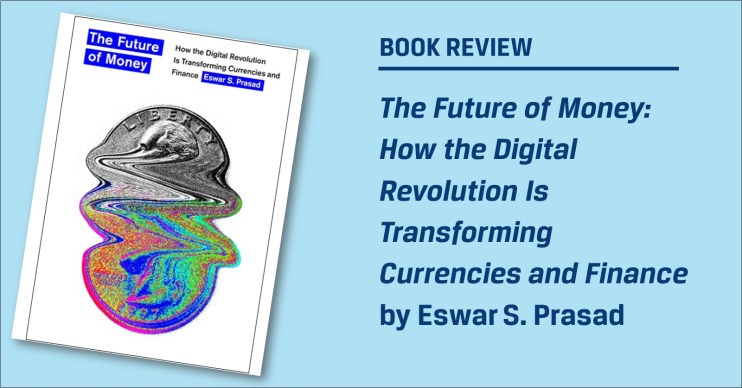
‘The Future of Money’: book review

Are cryptocurrencies the next big investment, a fad or a currency that will transform the economic and financial landscape? What are some of the advantages and shortcomings of digital currencies? Who will benefit from them?
Eswar S. Prasad attempts to address these questions in The Future of Money: How the Digital Revolution Is Transforming Currencies and Finance. Prasad, the Tolani Senior Professor of Trade Policy at Cornell University in New York state and the author of several books on currencies, provides an insightful exposition on the shifting landscape from traditional paper notes to digital currencies.
Prasad begins with a quote from Cecilia Skingsley, the now former deputy governor of Sweden’s central bank: “If you extrapolate current trends, the last note will have been handed back to the Riksbank by 2030.” Skingsley, who has recently moved to head the Bank of International Settlements Innovation Hub, is not the only government official who sees a grand future for digital currencies. China is another country that has been moving away from paper currency. In the US, President Biden signed an executive order to ensure digital assets’ responsible development in March 2022.
Banking on the move and blockchain
The ‘Innovations’ section begins with a chapter titled ‘Will Fintech Make the World a Better Place?’. The author takes us through the history of fintech, which he points out is a catch-all term for novel financial technologies. However, some innovations, such as the ATM, have become so ubiquitous that we forget these were once novel technologies. The history includes an interesting look at innovations, such as M-Pesa, which allowed individuals in Kenya to conduct banking through a mobile phone, as well as peer-to-peer lending, crowdfunding, and on-demand insurance. Many of these new services will pose challenges to traditional financial services companies.
Today, fintech is most closely associated with cryptocurrencies, such as Bitcoin and Ethereum. However, a discussion of cryptocurrencies cannot begin without understanding blockchain. This technology has been touted as the future of finance and of numerous other areas of business, including securing of medical records, non-fungible token (NFT) marketplaces, and supply chain and logistics monitoring.
Most investment professionals will be aware of blockchain and the concept of a decentralised ledger across a peer-to-peer network, but many may not understand the technology thoroughly. Prasad provides a detailed but accessible explanation of how blockchain works, from its origins to the underlying technology. The term ‘blockchain’ is associated with a variety of cryptocurrencies. However, the protocols used to validate transactions differ for various blockchains. Furthermore, each protocol has advantages and weaknesses. Will many alternative protocols continue, or will one emerge as the industry standard?
Prasad debunks some of the myths of crypto and other digital currencies. For example, many view using cryptocurrencies, such as Bitcoin, as a way to maintain anonymity. The reality is that, unlike cash, digital currencies require identifiers for consumers to receive goods purchased with digital currencies, which removes the anonymity. Blockchain has also been viewed as a secure technology. Although this technology offers greater security than other methods, Prasad points out ways that individuals can hack the various protocols.
Like all new technologies, the fintech revolution has brought with it a whole new language to define the new offerings, including hashing, security token offerings (STOs), smart contracts, initial coin offerings (ICOs), hash time locked contracts (HTLCs) and stablecoins. The Future of Money allows investors to learn the new vernacular of this field and consider which innovations may offer the greatest investable opportunities.
Insights for investors
The book is unlikely to provide any insights into how to value cryptocurrencies or how digital currencies, such as Bitcoin, are likely to replace government-issued money as a store of value, a medium of exchange or a unit of account. However, Prasad offers a glimpse into the potential for digital currencies in the chapter ‘The Case for Central Bank Digital Currencies’. He maintains that CBDCs can improve efficiency on the wholesale side by improving the way central banks distribute reserves to commercial banks. On the retail side, CBDCs may offer several benefits, including providing a back-up payment system, promoting financial inclusion, and improving monetary and fiscal policy.
Although these chapters may seem to be of greater interest to monetary economists and central bankers than to investors, Prasad provides some insights from which investors may benefit. He recaps a study that analysed how policies by some European countries to reduce the use of cash shrank the shadow economy and increased tax revenues. The thoughtful investor might ask which investments will benefit from these increased tax revenues. Will the additional revenues be used to fund infrastructure spending? Will countries use the windfall to finance alternative energy projects? Perhaps countries ruled by conservative lawmakers will choose to return the money to citizens and businesses through tax cuts. If that proves to be the case, which industries are likely to benefit?
Innovations produce winners and losers by creating new opportunities and challenges for incumbents. Financial industry innovations are no different. Understanding some of the current and potential future changes will enable analysts to better determine which businesses and industries are likely to prosper and which are likely to suffer. The Future of Money provides readers with a window into some of the opportunities and challenges that lie ahead.